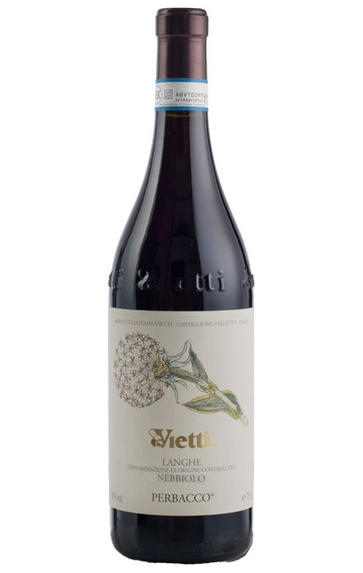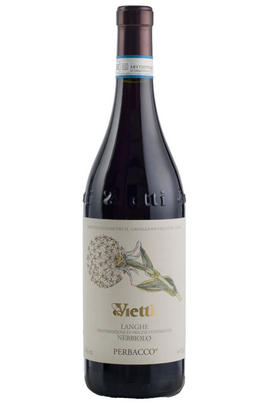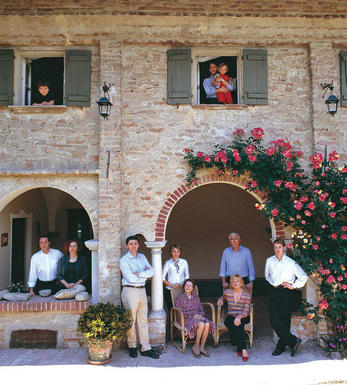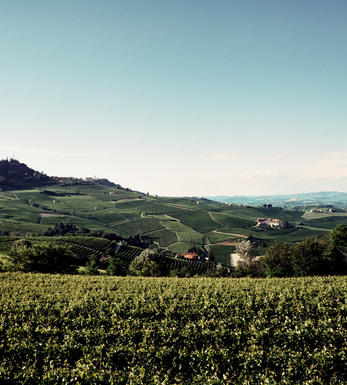
2018 Langhe Nebbiolo, Perbacco, Vietti, Piedmont, Italy

Critics reviews
Forget baby Nebbiolo! This assertive wine from Vietti is a stylish Langhe with a sleek nose and bracing palate. Bright ruby in the glass has telltale Nebbiolo aromas of rosehip and orange peel. Strawberry fruit is accompanied by firm, polished tannins, crisp acidity, and a fantastic rhubarb savouriness that carries the finish. It comes from a selection of grapes in both Barolo and Barbaresco, mainly on the classic combination of limestone and clay. The wine is then aged for two years in Slavonian oak casks.
Drink 2021 - 2028
Aldo Fiordelli, Decanter.com (March 2021)
About this WINE

Vietti
The Vietti family has been producing wine for four generations in Castiglione Falletto, at the heart of the Barolo area. Carlo Vietti founded the winery in the 1800s and his son Mario and the next generations carried on his legacy, focusing on improving the production.
Then, in 1952, Alfredo Currado (Luciana Vietti’s husband) was one of the first to select and vinify grapes from single vineyards (such as Brunate, Rocche and Villero). This was a radical concept at the time, but today virtually every vintner making Barolo and Barbaresco wines offers “single vineyard” or “cru-designated” wines.
Today, the winery is in the hands of Luca Currado Vietti and is considered to be one of the very best Piedmont producers. Their wines are highly sought-after, with beautifully designed labels as well as wonderful wine. In 1970, Alfredo and Luciana decided to support to some local artists and have selected labels turned into artworks. Artists such as Gianni Gallo, Eso Peluzzi, Pietro Cascella, Mino Maccari, Pier Paolo Pasolini, Claudio Bonichi, Valerio Miroglio, Pierflavio Gallina, Gioxe de Micheli, have had their works displayed to a much wider audience via the bottles of Vietti wines. In 1996 the most recent artist series label came from American realist Janet Fish on Vietti’s 1990 Barolo “Villero.” The whole collection of artist labels was shown at the Museum of Modern Art of New York

Langhe
Langhe is an all-encompassing zone lying due south of Alba and the River Tanaro in the province of Cuneo. Barolo and Barbaresco both lie within its boundaries.
Langhe is also the name of a regional DOC zone, which is used to classify wines made outside of the traditional Piemontese varietal scheme (Nebbiollo, Barbera, Cortese etc). Chardonnay and Sauvignon Blanc wines from the region are, for example, classified as Langhe DOC.
Langhe Nebbiolo
Effectively the ‘second wine’ of Piedmont’s great Barolo and Barbarescos, the Langhe Nebbiolo DOC is the only way Langhe producers can declassify their Barolo or Barbaresco fruit or wines to make an early-drinking style.
Langhe Nebbiolo can be released onto the market as soon as practicably possible either as a fresh, fruity wine made solely in stainless-steel, or later on having been aged in oak. The Langhe Nebbiolo DOC was created in 1994 along with a plethora of other Langhe DOC wines (so diluting their significance).
Unlike Nebbiolo d’Alba, Langhe Nebbiolo can be cut with 15 percent other red indigenous varieties, such as Barbera or Dolcetto. Leading, quality producers of Barolo and Barbaresco are more inclined to use 100 percent Nebbiolo, recognising its role as a stepping stone, using the fruit from vines that are either too young or poorly situated.
Larger producers tend to use the Langhe Nebbiolo DOC as a valve, declassifying wines destined for Barolo or Barbaresco when the market is difficult. Confusingly Langhe Nebbiolo can also be the declassified wine of Nebbiolo d’Alba.
Recommended producers: Giovanni Rosso di Davide Rosso , Mario Fontana , Ferdinando Principiano

Nebbiolo
Nebbiolo is the grape behind the Barolo and Barbaresco wines and is hardly ever seen outside the confines of Piedmont. It takes its name from "nebbia" which is Italian for fog, a frequent phenomenon in the region.
A notoriously pernickety grape, it requires sheltered south-facing sites and performs best on the well-drained calcareous marls to the north and south of Alba in the DOCG zones of Barbaresco and Barolo.
Langhe Nebbiolo is effectively the ‘second wine’ of Piedmont’s great Barolo & Barbarescos. This DOC is the only way Langhe producers can declassify their Barolo or Barbaresco fruit or wines to make an early-drinking style. Unlike Nebbiolo d’Alba, Langhe Nebbiolo can be cut with 15% other red indigenous varieties, such as Barbera or Dolcetto.
Nebbiolo flowers early and ripens late, so a long hang time, producing high levels of sugar, acidity and tannins; the challenge being to harvest the fruit with these three elements ripe and in balance. The best Barolos and Barbarescos are perfumed with aromas of tar, rose, mint, chocolate, liquorice and truffles. They age brilliantly and the very best need ten years to show at their best.


Buying options
Add to wishlist
Description
Forget baby Nebbiolo! This assertive wine from Vietti is a stylish Langhe with a sleek nose and bracing palate. Bright ruby in the glass has telltale Nebbiolo aromas of rosehip and orange peel. Strawberry fruit is accompanied by firm, polished tannins, crisp acidity, and a fantastic rhubarb savouriness that carries the finish. It comes from a selection of grapes in both Barolo and Barbaresco, mainly on the classic combination of limestone and clay. The wine is then aged for two years in Slavonian oak casks.
Drink 2021 - 2028
Aldo Fiordelli, Decanter.com (March 2021)
wine at a glance
Delivery and quality guarantee